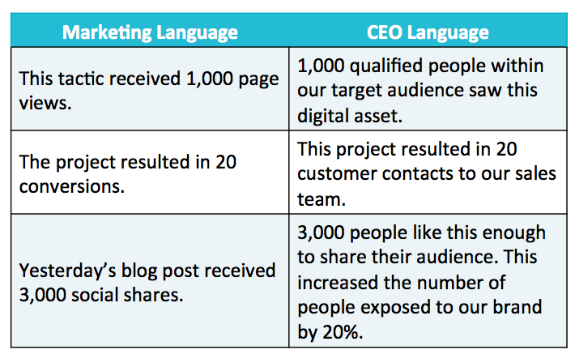
Raise your hand if you’ve ever encountered a situation like the one described below:
It’s time again for your annual marketing budget meeting. You’re confident that what you’ve put together is going to knock the leadership team’s socks off.
You begin rocking through your amazing slide deck, chock full of powerful data points such as the number of Facebook Likes and banner ad clicks. Everything seems to be going great, and you know that this is the year you’ve finally proven the value of digital marketing and will win more budget. This means more budget to create additional content, place more ads and maybe even hire a great agency to help augment internal marketing efforts.
“Sure.” your CEO says, “That all looks great, but what are we going to get out of it?”
“Brand awareness, views, clicks, shares” – you say.
“No.” they say pointedly, “What are we really going to get out of it in terms of new customers, revenue and sales?”
A recent study from Econsultancy found that only 44% of marketers surveyed believe that the C-Suite really gets digital marketing and is developing an effective strategy. This can create many challenges for today’s digital marketers.
So how do you convince the C-Suite of the power of digital marketing when it comes to meeting business objectives and win that bigger budget?
Step 1: Become Fluent in CEO Speak
In my day to day, I spend most of time talking with other agency and client side marketers. Fortunately we are all speaking the same marketing lingo of conversions, page views and bounce rates. However, in order to get your CEO on board, you’ll need to step away from the marketing speak and dial into language which resonates with your audience:
For example:

Step 2: Do a Landscape Audit, Don’t Forget Your Competition
Try to remember that most CEO’s don’t live and breathe digital marketing. They may not be aware that 83% of B2B marketers have a content marketing strategy in place. Or that there are 350 million users on LinkedIn. Set the stage by letting them know what is going on in the industry.
Keep in mind however that all the 3rd party research in the world won’t lead to an increase in budget, but showing a competitor that is applying a similar tactic and doing well will. C-suite is often intrinsically motivated by the idea that their competitors may know something they don’t.
Create a simple matrix of your top competitors and who is using which tactics. Then use a competitive audit tool like SEMrush to find data for PPC ad spend and traffic volume. Pull this data into a PowerPoint deck, and include screen shots of impressive ad campaigns or downloads to show value to your CEO.
Step 3: Show Them What They Stand to Gain (Or Could Lose)
When preparing to present to your leadership team, make sure that you:
Know what your CEO really cares about. Sometimes we assume CEO’s only care about the bottom line, but they may have many other objectives for the upcoming year. Examples could include: increasing brand visibility, attracting new customers from top competitors, or a higher volume of product sold.
Nail down tracking. If you don’t have the tracking in place to tie back each of your marketing tactics to an objective your CEO really cares about, then make sure you laser focus on making that a reality. Leverage custom tracking URLs and some advanced Google Analytics segments to document tracking of visitor flow and conversions from pretty much any digital marketing tactic. If you need more advanced tracking, begin researching marketing automation systems, and plant the seeds for a big investment in 2016.
Perhaps you already have tracking in place. The next step is to show your team what they stand to gain.
For example:
- 2015: Created 4 gated downloads = 800 leads
- 2016 (Double the investment): 8 gated download = 1,600 leads
If you can present a case for investing in 4 additional content marketing assets, and the standard cost per lead, then you can show the potential ROI on additional content objects.
Now let’s flip that on its head. By not investing these dollars in 2016, you stand to lose 800 new leads. Psychologically, showing what your boss stands to lose is often more compelling than a potential reward.
Step 4: Start Small to Win Big
When testing a new tactic or platform, like Google AdWords or co-created content, I always advise clients to start small. You must invest enough to run a true test, but consider it in terms of percentage of available budget.
I recommend that companies invest 70% of available budget in tried and true tactics that you know produce results, 20% on medium risk tactics, and only 10% on those brand new, high-risk tactics. This strategy ensures marketing is creating the results you need, while still making room for testing new tactics that have the potential to drive big results.
If you are asking for a 25% increase in budget, show your CEO the breakdown of how you will be spending that budget. Knowing you are investing the lion share in proven tactics, can help show that you are aiming to make a sound investment.
If you’re looking for more help crafting your pitch, speak with your current agency and have them provide you with more results from the previous year and their recommendations for next steps.
If you’re not working with an agency, reach out to an agency like TopRank Marketing and see what recommendations they have or what they would provide you if you worked with them.
Image: Shutterstock


